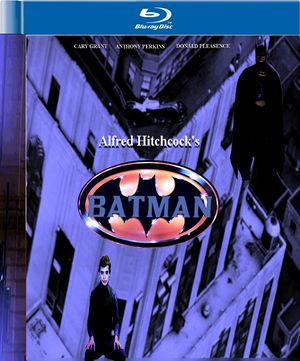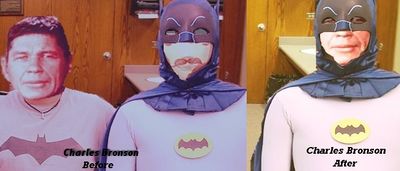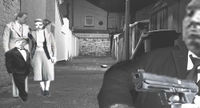User:PF4Eva/Batman (Alfred Hitchcock film)

“There's something familiar about this picture.”
“Why so serious?”
Batman is an unreleased 1968 film based on the Bob Kane and DC Comics Batman characters. Directed by Alfred Hitchcock -- and starring James "Jimmy" Stewart as Bruce Wayne/Batman -- it was darker in tone from the 1966 ABC Batman television series starring Adam West as the Caped Crusader.
After a negative response from audiences after viewing the trailer, the film was withdrawn from its planned January 16, 1968 release.
Production[edit | edit source]
Pre-production[edit | edit source]
In 1966, influential director and comic book enthusiast Hitchcock, was invited by a friend, actor Gregory Peck, to see Batman: The Movie, based on the campy West TV series; Peck was good friends with West and Cesar Romero, TV's The Joker. Hitchcock, a closeted Batman fan, was appalled by the campiness and goofy, spoofy nature of the film. However, these flaws gave the visionary Master of Suspense a clever idea.
The next day, Alfred Hitchcock met with executives from National Allied Publications -- which would later rename itself DC Comics in 1977 -- and 20th Century Fox about doing more serious Batman fare. He said he intended to direct the film as "a superhero psychological thriller; similar in tone to the earlier Batman comics I loved reading in the 1930s and '40s. Batman should be portrayed, not as a spandex-wearing poof, but as a tragic millionaire by bright day, costumed vigilante by dark night." Executives loved the idea, but thought that it conflicted with the TV series, so a decision was made to sabotage the show and take as long as they wanted with the movie. Hitchcock ran into a few problems with making his film, as he was still under contract with Universal; it was ultimately decided that Batman would be a joint venture between the two studios.
Screenplay[edit | edit source]
The director sought the help of longtime collaborator John Michael Hayes to pen the script that would redefine the iconic superhero. The two had previously collaborated on Rear Window (1954), To Catch a Thief (1954), The Trouble with Harry (1955), and The Man Who Knew Too Much (1956).
An early draft of the film featured as the main villain The Penguin, to be played by Ernest Borgnine, if not Marlon Brando or Edward G. Robinson. Borgnine turned down the part, stating that the only way he'd willingly do the movie is if actor Clint Eastwood were directing. [Eastwood didn't direct his first film until 1971's The Beguiled: The Storyteller.]
Brando didn't get the part for two reasons: a) he wasn't fat enough, and b) Hitchcock couldn't understand a word he was saying. "I'd rather cast Popeye as the Penguin," he said.
Robinson, who once guest starred as himself on the TV series, was appalled by the dark nature of the film, claiming that Hitchcock had raped the Batman legacy. The director argued that Adam West had, in fact, raped by Batman legacy.
With all three actors on the shortlist crossed off with no success, Hitchcock told Hayes to scrap the character, and rewrite the screenplay with The Joker as the main villain, and Two Face as a supporting villain.
Casting[edit | edit source]
The casting officially began in March of 1967, after lengthy rewrites and other issues.
When casting the title role of Batman/Bruce Wayne, Alfred Hitchcock let his friend Gregory Peck read for the part. He felt that the actor was too comedic for the role, and, at 50, too old for the part. Hitch wanted someone younger, such as 22-year-old Rutger Hauer, who had never acted on screen before but was a good friend of the Master of Suspense. He met Hauer when the actor performed as Norman Bates in a college play based on the director's 1960 film, Psycho.
The studios wanted a "name" actor, a well-known actor, to play the part. Their first suggestion was 45-year-old Charles Bronson. Bronson had, in fact, appeared in three episodes of Alfred Hitchcock Presents, and was best known at the time for his role in 1963's The Great Escape. Bronson was gleeful to finally be able to "kill muggers." However, Batman creator and film executive producer Bob Kane -- a Bronson fan -- balked at the thought of his favorite actor portraying the Caped Crusader. He felt that Bronson could never in his life play a convincing vigilante. After his rejection, Bronson went back to work on The Dirty Dozen, which was released later that year.
Plot[edit | edit source]
Millionaires Thomas and Martha Wayne (Played by Joseph Cotten and Tippi Hedren, respectively) are going home after seeing a movie with their son, Bruce (Played as a child by Ronny Howard). Unfortunately, what would have been a pleasent night turns into tragedy when a man named Joe Chill (Hitchcock in his usual director cameo) pulls out a gun and shoots and kills Mr. and Mrs. Wayne. Bruce Wayne, traumatized, begins crying and calling for help, causing Chill to run off before the police arrive. The Waynes' butler Alfred Pennyworth (Donald Pleasence) hears all the chaos and runs to Bruce's rescue, becoming a father figure to the young heir for the rest of his life.
Several years pass, and Bruce Wayne (James Stewart) is among the wealthiest men in Gotham. When a crime spree hits the city, amid police corruption, Bruce decides to take the law into his own hands. He makes himself a state-of-the-art bat costume and utility belt with the help of butler Alfred and Wayne Enterprises gadget man Charles Fox (Sidney Poitier). [Charles Fox was an original character not seen in the comics until he, as Lucious Fox, made his debut in Batman #307 in January 1979.] Under the alias of "Batman," and with his true idenitity a guarded secret, Bruce somewhat befriends Police Commissioner James Gordon (Leo G. Carroll) of the Gotham City Police Department. Gordon is not quite sure whether this new vigilante is a hero or a threat.

